Expressive Flowers in Watercolor
This week, I share how I found the expressive idea for this floral watercolor painting. I go into more detail about this process in the course Freely Grown.

This week I am presenting a watercolor that is part of a small series I painted for the gallery Gumbostrand Konst & Form. The title of this piece is “Syvältä selviytyneet” in Finnish. The English translation could be “Survivors of the Deep” or “those who survived the deep.” The first of the series was “Talven voittaneet” – winners of winter.
Starting with Random Strokes and Splashes
When I start painting, I usually have no idea what the finished piece will express. That keeps my excitement up! The flowers grow gradually and the overall expression takes turns during the painting process.
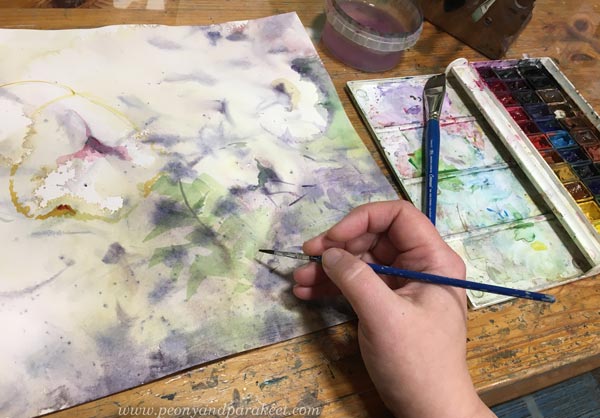
Even now, I only had an assignment to paint flower paintings with watercolors in the same style as what I had already painted earlier this fall. After the first random layers, I could see big flowers.
Wondering About the Expression
The large size and fearless look of the flowers reminded me of strong wild animals. But the further I painted, the more I began to think about the environment where the flowers had appeared.

In nature-themed paintings, it’s important to find the right atmosphere, and that’s where the location matters a lot. I got the feeling that these flowers can withstand even the harshest conditions. Would they live in the desert?

But the softness and roundness of the flowers told of something other than the desert.
Finding the Answer from the Flowers
I looked at the big rose at the bottom edge and asked myself where a flower could swell before decomposing. Then I realized that these have come from deep water and are on their way to the surface. After that, it was easy to add the references to water – like bubbles and water lines – and finish the painting. Painting expressive flowers in watercolor is not only about adjusting the flowers but also finding their back story.

I think it’s a wonderful idea that you can not only grow from difficulties but also soften. And that difficulties can be overcome by staying together. Surface water which seems cold and drowning to others, can be like a gentle sea of light to these survivors.
Every time I paint flowers, my mood rises!
Pleasures of Watercolor Painting
This week is about watercolor painting and the pleasures that can be found there!

Getting Inspiration
Now I’ve been busy with a lot of different things – a new big art project, the new course Freely Grown, commissioned work, etc. Despite that, I stole some time and went to look at old paintings online – skillfully painted portraits of women in fancy dresses. They always make me want to paint, even though I prefer to paint plants and flowers instead of beauties.
Look at this painting of the Duchess Alexandra Iosifovna, painted by Franz Xaver Winterhalter in 1859!
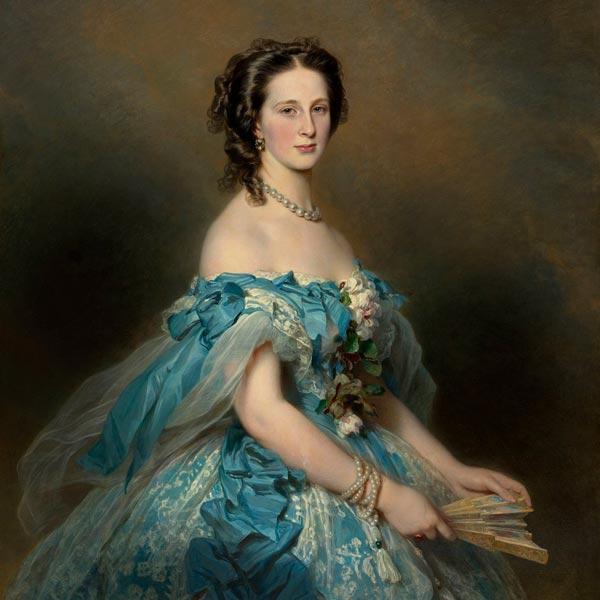
A detail – only a part of the painting is in this image.
The colors, the brilliant brush strokes, and all the delicate and decorative details are so inspiring!
I used to think that inspirational images must be the same as what I want to paint next. So, if I wanted to paint flowers, then I would only look at flower paintings. But nowadays, I love to be inspired by something different. Then the inspiration doesn’t limit me. It doesn’t depict what I should do and how, but sets an atmosphere that I want to follow.
Love for Good Watercolor Paper
After getting inspired, I opened the closet of my studio, as if secretly from myself, and tore a clean sheet from the watercolor paper pad.
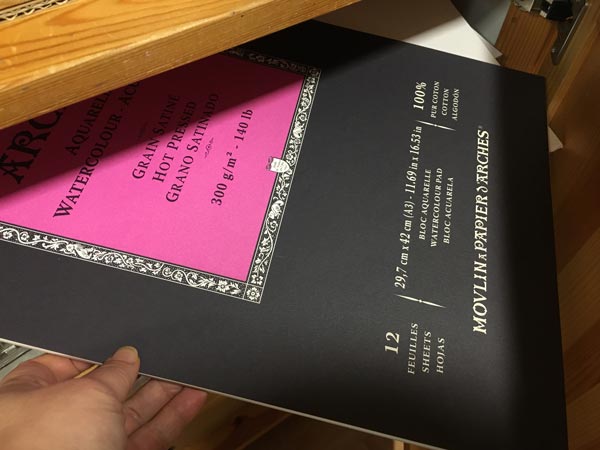
One hundred percent cotton, aah! So soft, thick, and ready to receive color. Good paper is expensive, but I paint better when I know in advance that I don’t want to waste a sheet.
Painting and Doing Other Stuff at the Same Time
When I steal time to paint, watercolors are an easy choice. Especially in the beginning, I can do one coat quickly and then let it dry for hours while I do other work.
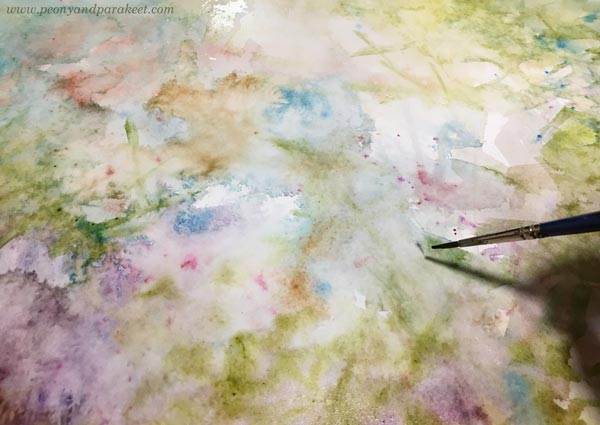
I can add details little by little, and the pauses often just clarify the idea of the subject of the painting. And when you paint slowly from light to dark, you can always fix it with the next layer.
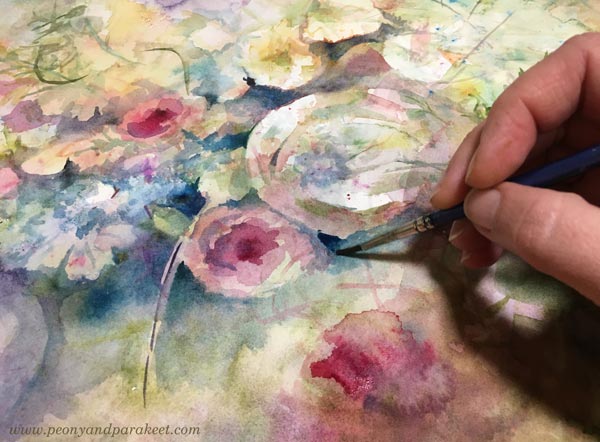
I often have my iPad nearby and listen and watch something at the same time while I paint.
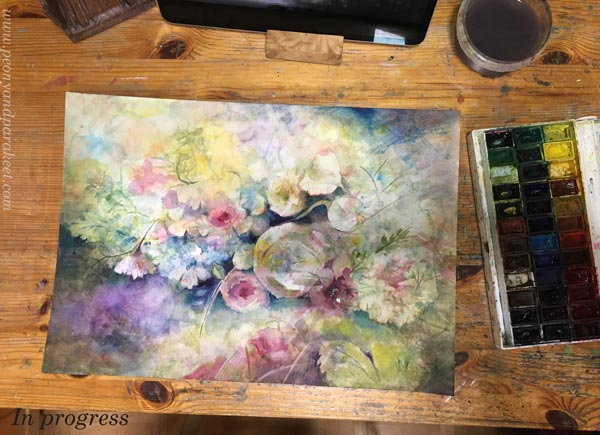
Luxury Combined with Minimalism
When finishing, it’s pleasurable to take just a little color on the brush, and often near the pan, if it has spilled there. I also check the corners of the palette, where unused paint easily remains. When the color is activated on paper, even a small amount becomes a treasure and an experience!
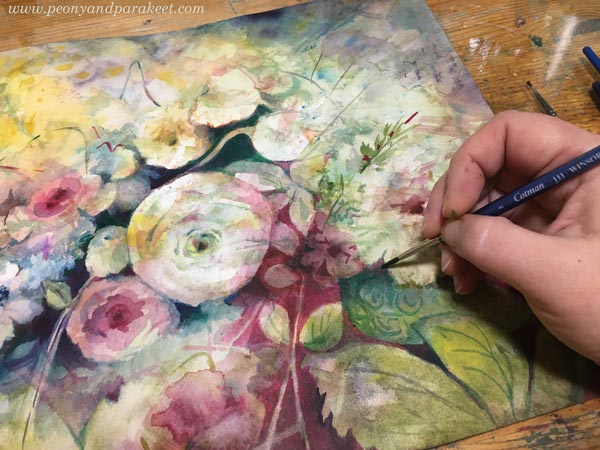
I always buy good artist-quality watercolors one pan and one tube at a time and use them right up to the end. If I buy a tube, I squeeze a small amount into a pan to dry and this way, use the tube in small portions. I love this kind of union of luxury and minimalism – definitely one of the pleasures of watercolor painting to me!

Finally, I wash the brushes carefully. Washing with water is enough for most brushes, but I often use soap to make sure that all the color has come off. With clean brushes, it’s nice to start a new painting again when I find time.
From Detail to Detail
Here are some pictures of the details.

I like to paint a lot of subtle details, and I love the warmth that yellow has.

Signing the piece before the final finishing touches makes sure that the signature fits with the rest of the composition.

I hope this blog post inspired you to pick watercolors and paint freely!
P.S. Freely Grown – You can still hop in!
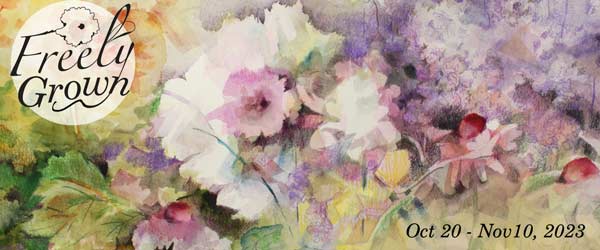
Painting Flowers Freely with Watercolors
This week, I share thoughts about my new course Freely Grown, and about its central idea of allowing the painting to grow freely.
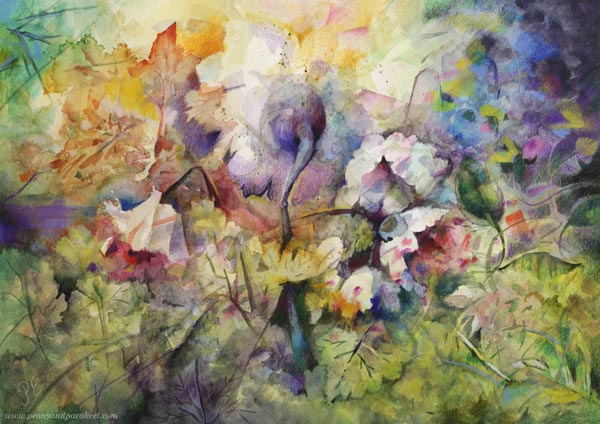
I’ve been in a really good mood lately. I have two great sources of joy. The first is that a new period in my life will begin this month when I start a year-long half-time grant period for digital artwork. Another source of joy is the new course Freely Grown, which I started making in the summer and whose material I have now been finishing.
Freely Grown
This course has been like a friend to me and I hope it will be like that to you too. Like paintings, courses also have their own character. This course is both playful and goal-oriented. I usually look for a suitable course name for many months, but this one gave me its name right away and I haven’t even thought about alternatives!
I’ve been so enthusiastic about the subject of the course that the abundance of plants is appearing in the work planner too.

Painting Flowers Freely
I am really inspired by the idea that a plant can grow freely. I don’t think it has to be a wildflower at all. Even if a plant grows in a flower bed, the gardener can let it sprawl. Similarly, our lives can have certain routines and restrictions, but still, imagination can grow freely.
When the brush spins and twists on the paper, it’s wonderful to indulge in its play. The painting can also grow freely.
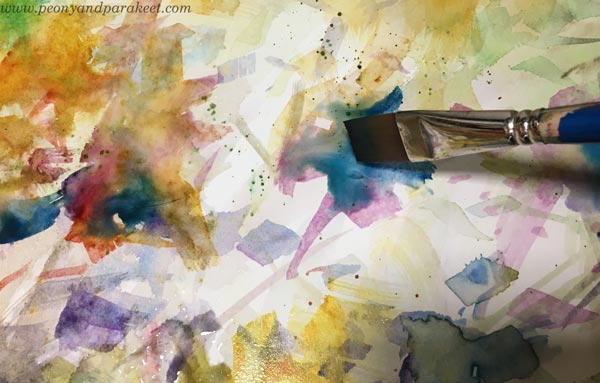
I like to consider that a painting is an independent party, not so much an extension of my own self. When I relax a little about what I want and let the painting suggest a direction, a new kind of pleasure is offered, even an adventure!
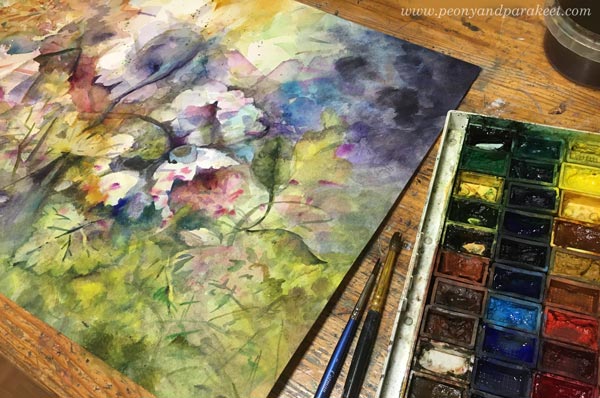
A surprising thing in this painting was that the largest flower suggested turning away from the viewer. I wondered if I could let it do that. Would the setting look impolite?
But when I study old flower paintings, their natural charm is that the flowers stretch out in every direction. So why couldn’t we let our flowers grow freely where they want?
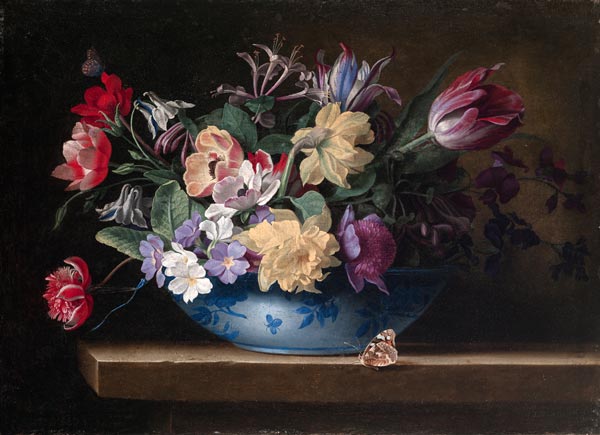
Only when the painting was about to be finished did I realize that the flower turns towards the light as if to welcome a new era! When you give the painting freedom, you always get more than if you strictly control it.

I think this A3 size (11.7 x 16.5 inches) is really nice because it’s big enough. It’s hard for the flowers to look expressive if they are very small.
Coloring on Watercolor Painting
When I finish with colored pencils, I aim for the colored parts to continue painting naturally.

Here you can see a close-up of the coloring. I always leave watercolor visible too.

I’ve done a lot of colored pencil stuff in the last couple of years and the number of pencils has reduced. But it’s fun that every now and then I can buy an out-of-stock color and introduce a new arrival to the old pals.

I love this abundance of flowers – born by painting freely, without reference pics!
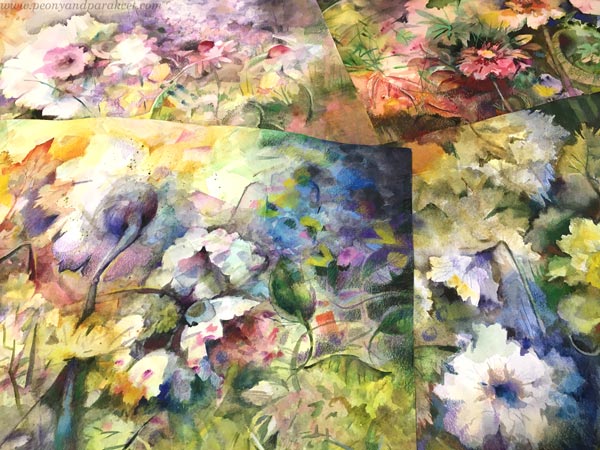
I hope you will come to the course!
How to Combine Watercolors and Colored Pencils
In my new online course Freely Grown, we will use watercolors and colored pencils for a flower painting. Here are the basics for using both in the same piece.
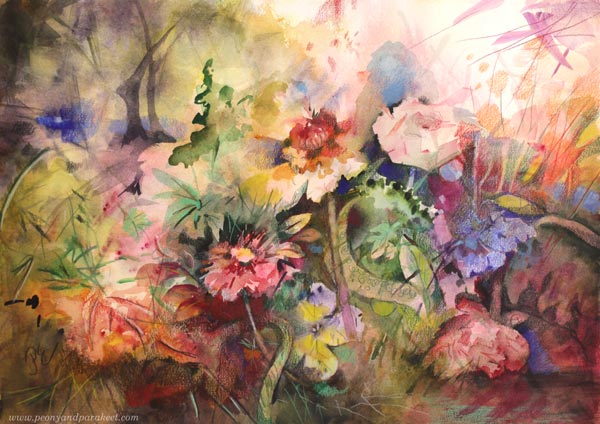
Watercolors and colored pencils have quite a lot in common, even though one is used for painting and the other for drawing.
Choosing the Paper
Both like thick and smooth watercolor paper. Of course, watercolors like textured paper too, but colored pencils are a bit more selective. I find it most enjoyable to color on Hot Press quality paper that has very little surface texture. But if you only have textured Cold Press paper in your stock, just start experimenting right away and buy smoother paper later!
All Brands Work Together
In both watercolors and colored pencils, you can combine different brands.
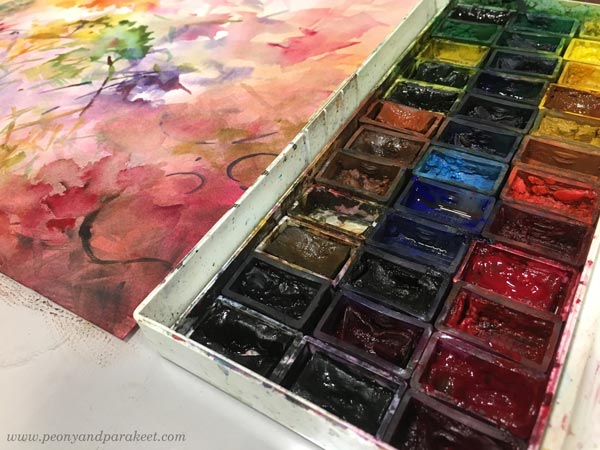
I also have many different brands in my watercolor set and even though I work with pans, some of the pans are pressed from tube colors. And I love to try different brands of colored pencils and organize them by color family.
Proceed Layer by Layer
When creating, it is good to start carefully with both watercolors and colored pencils. Introduce a new color little by little and change it layer by layer. Always dry the lower layer of watercolor first before adding another layer on top.
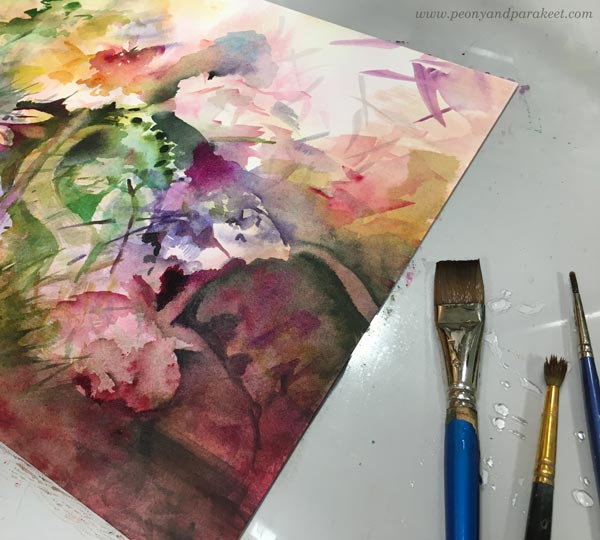
Translucent layers produce new color mixes. By saving the effect of white paper, you will have a more effortless look than if you color white later.
Watercolors First, Colored Pencils Second
You can color over a dry watercolor painting with colored pencils, but not vice versa. Sure, there are watercolor pencils that dissolve in water, but I usually use all of them dry. So I do a watercolor painting first, and then finish it with colored pencils.
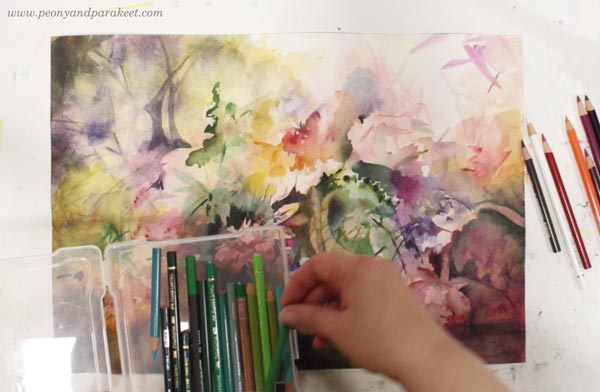
Painting with watercolors is fast, but drying between layers takes time. Colored pencils are slow, but the mark is detailed and you can immediately add a new layer.

The quickest solution is to paint most of the work with watercolors and only emphasize the highlights and add details with colored pencils.
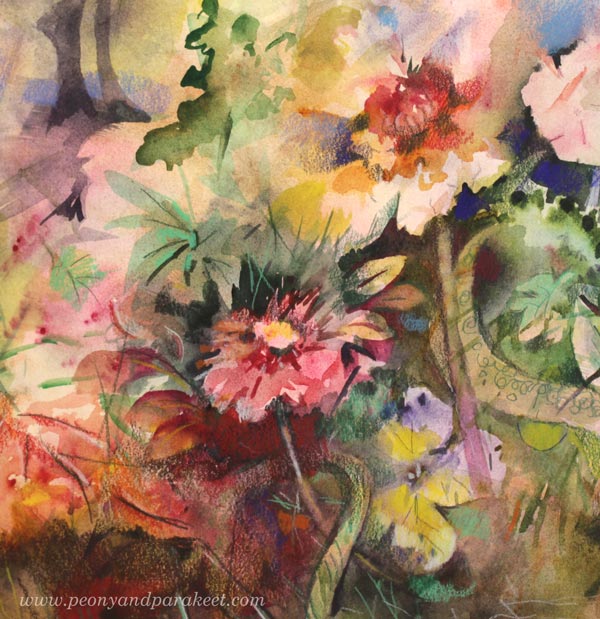
Freely Grown – Sign up Now!
Combine watercolors and colored pencils and create paintings where nature’s abundance takes over! >> Sign up for Freely Grown!
The early-bird sale ends on Oct 1st, 2023, at midnight PDT. Sign up now!